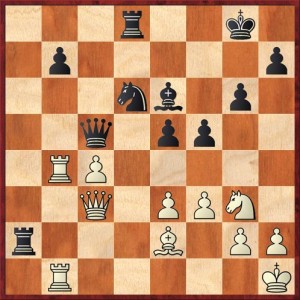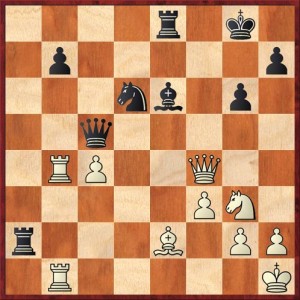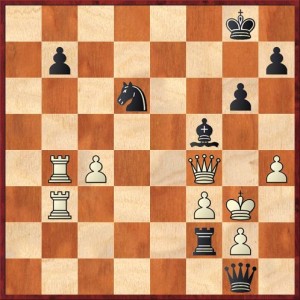As some of you might have noticed, I took a short break from blogging and from chess in general for the last two weeks. My wife and I went back to North Carolina and Virginia to see (respectively) her family and my family. It was our first trip together to the east coast in eight years — far too long! The heat and humidity were probably even more brutal than we remembered, but we had a good time as long as we could stay inside, in the air conditioning.
And now, back to chess. What am I going to show you after a two-week hiatus? Well, I always like to go down memory lane. The most appropriate thing, after a trip to North Carolina and Virginia, would be to write about my chess-playing years in those states. But the problem is that I’ve already done that. See Virginia Memories and Chess Memories (1980s edition) and Winning the State (parts 1-4) and even The Post That Never Got Posted, which drew an interesting comment from my opponent who I had not seen in 20 years.
So let’s move on to the next phase in my chess life, the Ohio years. In 1989, newly married, I moved to a small town in rural Ohio to teach at Kenyon College, and my wife and I lived there for 7 years. The odd thing about this period is that the #1 highlight in the chess sense came in my very first tournament, the Roosevelt Open in Dayton in 1989. Remember that nobody knew me because I had never played in Ohio before, so it was a big shock when I came in and won the tournament with a 5-0 score! The key wins came over Ron Burnett (then rated 2507) in round four and Norris Weaver (who I believe was 2300-something) in round five.
Ron remains the highest-rated player I have ever beaten. According to my USCF member page I have never beaten somebody rated over 2500, but their computer records do not go back far enough to include the Burnett game. Interestingly, I actually beat him again a few months later, so I have a 2-0 lifetime record against him!
One of the interesting things about the Roosevelt Open was that it was the first time I ever saw a player named Joe Kennedy. He was the most severely disabled player I have ever seen in a tournament: quadriplegic, confined to a wheelchair, nearly deaf and legally blind. Yet he was a USCF expert and multiple-time U.S. blind champion! Some blind players can “visualize” the position by feeling the pieces on a special peg board. But Joe, being paralyzed, did not have that option — he literally had to “play blindfold.” He made his moves by telling an assistant (probably a family member) what he wanted to do. His speech, too, was difficult to understand, but they had plenty of practice.
It is amazing how much Joe accomplished in spite of his disabilities. This article by Mike Peterson will tell you more about him. The only thing I can add to it is that in his last USCF tournament he won the title of U.S. blind champion (in 1994). He must have died shortly after that, because I’m pretty sure it happened before I left Ohio (in 1996). This puts him in the company of Alexander Alekhine among the few chess players to die as champions.
After my initial success in Dayton, I “came to Earth” a little bit. The only other open tournament that I won was the Roosevelt Open again in 1993 (tying for first). I played in the Columbus Invitational Championship a few times, which was a lot of fun (a 10-man round robin tournament), but I could never get past Chuck Diebert and Chuck Schulien and Steve Wygle, who were the usual winners of that event.
Diebert in particular was a nemesis of mine (although in fairness, as a 2400 strength player he was tough for a lot of people). I think I had a lifetime record of 0-4 or so against him. They were always hard-fought games and painful defeats. One time we adjourned in a position where he was so confident of winning that he told me exactly what he was going to do. So I prepared a variation specifically to stop that — and when we resumed the game, he did something completely different! Moral: Never trust your opponent! Another time we got past the time control in a dead-drawn position, although I was a pawn up. TD Mark Zabel wrote in his booklet about the tournament, “The players could have split the point here, but they decided to wait to see if something would happen. Something did.” With a second time control of game/60, I proceeded to use 59 minutes to achieve a won position, while Chuck played more sensibly and conserved his time. In the frantic time scramble that ensued, I hung my rook and Chuck won again.
For a couple years I served as Games Editor of the Ohio Chess Bulletin, which aside from that was edited by Parley Long. This was back in the days before Windows, when I used some sort of clunky shareware DOS program (I don’t remember the name) to input all of the games. No ChessBase back in those days! The Computer Era in chess was coming, but it wasn’t coming fast enough.
Unfortunately I don’t have a whole lof other anecdotes from my Ohio years. Kenyon was too far away from Columbus to allow me to play in any chess clubs there. I organized a chess club on campus, but that was not a serious way to improve my chess because the best of the students were mostly in the class-C to class-B range. However, I’m glad to say that one of them, Shawn Pealer, stuck with chess and improved a lot after he left Kenyon. He later moved to North Carolina, thereby completing a trade of some sort! (Dana Mackenzie for Shawn Pealer.) He is an expert now and his rating is actually higher than mine is.
Finally, to wrap up this trip down memory lane, let me show you a position from my first and best tournament in Ohio, the 1989 Roosevelt Open. This was from the final round, when I was Black against Norris Weaver.
FEN: 3r2k1/1p5p/3nb1p1/2q1pp2/1RP5/2Q1PPN1/r3B1PP/1R5K b – – 0 24
Black has several attractive ideas: 24. … f4, 24. … Rda8, 24. … b5. Which do you think is best?
I think that White’s move was actually intended to provoke 24. … f4; a better move would have been 24. Kf1, protecting the bishop.
After careful consideration, I decided to “fall into the trap,” and I played 24. … f4! 25. ef ef 26. Qf6 Re8 27. Qxf4 (see Diagram 2).
FEN: 4r1k1/1p5p/3nb1p1/2q5/1RP2Q2/5PN1/r3B1PP/1R5K b – – 0 27
White has won a pawn, and I suspect that his analysis stopped there. If so, this position is a good lesson: Don’t stop your analysis while there are tactics still on the board! What did he miss?
The answer is 27. … Bf5!, after which White’s back rank is suddenly extremely sensitive. I’ll bet he wishes now that he hadn’t moved his king to h1!
A cute variation that I analyzed after the game is 28. R1b3 Ra1+ 29. Bf1 R8e1 30. h4 Rxf1+ 31. Nxf1 Rxf1+ 32. Kh2 Qg1+ 33. Kg3 Rf2! (see Diagram 3)
FEN: 6k1/1p5p/3n2p1/5b2/1RP2Q1P/1R3PK1/5rP1/6q1 w – – 0 34
Of course mate is threatened, and to create a flight square for his king, White has to move his queen. Unfortunately, he has no safe place to move it to! Whichever direction she goes, she runs into a skewer: 34. Qxd6 Rxg2+ 35. Kf4 Qh2+, or 34. Qh6 Rxg2+ 35. Kf4 Qc1+.
That isn’t what actually happened, though. After 27. … Bf5 the game ended 28. Nxf5 Raxe2 (threatening mate) 29. Nh6+ Kg7 30. h4 Re1+ 31. Kh2 Qg1+ 32. Kh3 Rxb1 33. Ng4 Qh1+ White resigns. One thing I think is especially pretty about this game is how Black’s knight on d6 holds everything together defensively, thereby allowing Black’s queen and rooks to run wild.






{ 2 comments… read them below or add one }
Nice tactics there Dana. Well am happy to check out your blog and I did not know you were from Ohio. I know a NM David Zimbeck who was from Ohio and wound up in Hollywood Ca. Then a year in Ensenada Mexico. Now he is back home in Columbus Ohio. Well I miss my gambiteer friend. Anyway wish you the best at the Western States Open and give them GMs hell . V/R Francisco
Thanks both for mentioning me and for the past instruction!